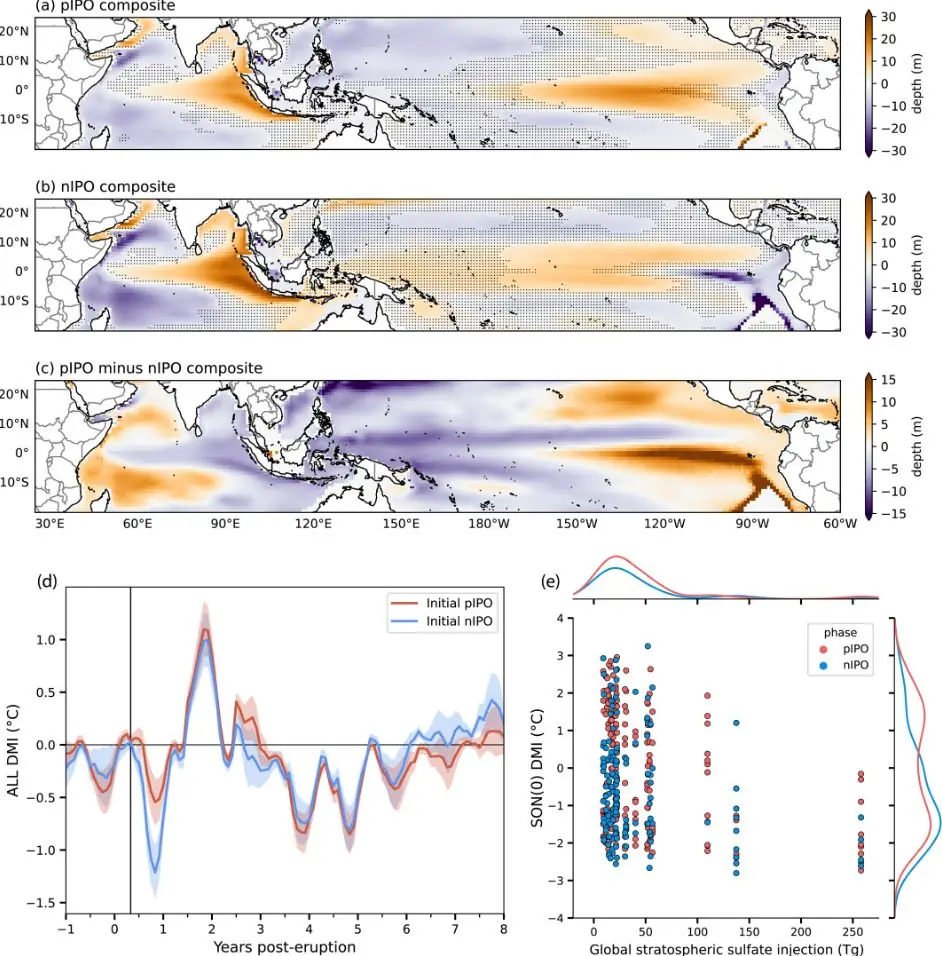Tropical volcanic eruptions disrupt Indian Ocean climate cycles for up to 8 years
A recent study published in Geophysical Research Letters has found that volcanic eruptions occurring in tropical regions can disrupt climate cycles in the Indian Ocean for up to 8 years. The research, conducted by scientists from MIT and WHOI, focused on the impact of volcanic eruptions on the Indian Ocean Dipole (IOD) and the El Niño Southern Oscillation (ENSO).
Volcanic eruptions in tropical regions, specifically within 23°N/S of the equator, have a lasting impact on climate cycles in the Indian Ocean, according to a study led by Benjamin Tiger from Massachusetts Institute of Technology (MIT) and Dr. Caroline Ummenhofer from Woods Hole Oceanographic Institution (WHOI). The research, published in Geophysical Research Letters, employed the Community Earth System Model Last Millennium Ensemble (CESM-LME) and data from historical eruptions such as Samalas in 1258, Kuwae in 1452, Tambora in 1815, Huaynaputina in 1600, and Pinatubo in 1991.
The simulations revealed that these eruptions induce a negative IOD phase within the year of the eruption, followed by a positive phase the subsequent year. This oscillation in IOD phases lasts for 7 – 8 years (2 555 – 2 920 days) before returning to baseline conditions. During this time, the eastern Indian Ocean experiences cooler than normal temperatures, while the western part becomes warmer. This temperature contrast leads to significant changes in weather patterns, including floods in East Africa and drought in East Asia and Australia.

The findings also disclosed that the Interdecadal Pacific Oscillation (IPO), a climate cycle that spans both hemispheres and lasts for 20–30 years, modulates the initial IOD response post-eruption. A negative IPO phase amplifies the negative IOD and vice versa. This modulation is significant enough to outweigh the general cooling trend observed in the tropics following an eruption.
In terms of ENSO oscillations, the research found that El Niño warming occurs particularly in the boreal winter months (December–February) of the first year post-eruption. This is followed by La Niña conditions. These shifts may be attributed to an enhanced temperature gradient between the land and sea of Africa and the Indian Ocean, as well as upwelling of cooler water in the eastern Pacific.
Another element influencing these climate responses is the depth of the thermocline, an abrupt temperature gradient within the Indian and Pacific Oceans. The thermocline depth varies according to the phase of the IPO at the time of the eruption, affecting the sea surface temperature gradient and, consequently, the IOD and ENSO responses.
The timing of the eruption also plays a role. Eruptions occurring in boreal spring (March–May) are most likely to impact the IOD/ENSO response within the same year. The aerosols released from these eruptions affect global radiative forcing, resulting in atmospheric cooling that can last for several months or years.
The study has implications for risk assessments in regions prone to volcanic eruptions, as understanding these connections could help in preparing for extreme climate events that follow.
References:
1 Tropical Volcanic Eruptions and Low Frequency Indo-Pacific Variability Drive Extreme Indian Ocean Dipole Events – Benjamin H. Tiger, Caroline C. Ummenhofer – AGU/Geophysical Research Letters – October 5, 2023 – https://doi.org/10.1029/2023GL103991
2 Volcanic eruptions found to dampen Indian Ocean El Niño events for up to 8 years – Science X Network – October 27, 2023
Featured image credit: Geophysical Research Letters, AGU/Authors

Commenting rules and guidelines
We value the thoughts and opinions of our readers and welcome healthy discussions on our website. In order to maintain a respectful and positive community, we ask that all commenters follow these rules.